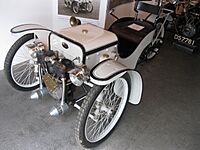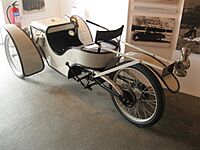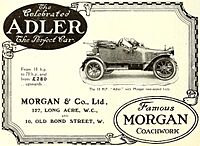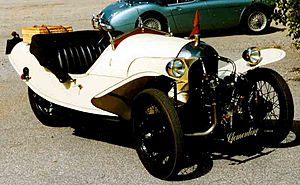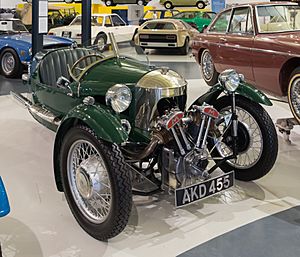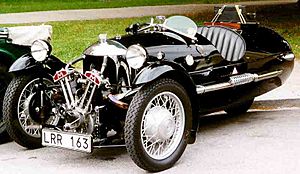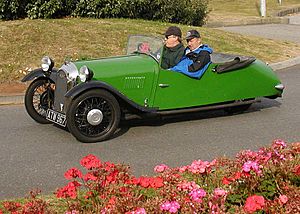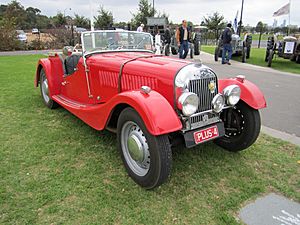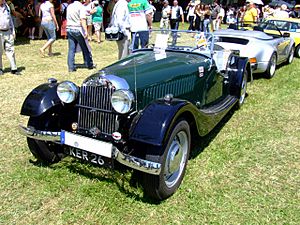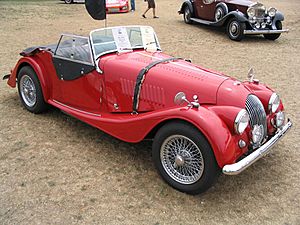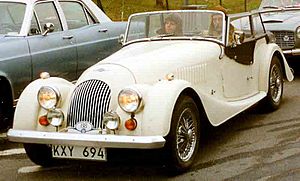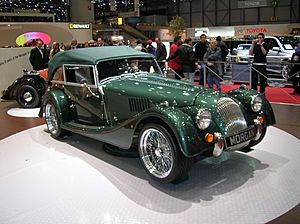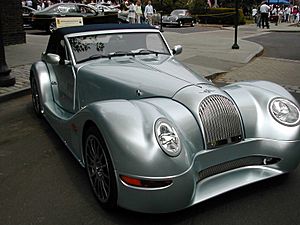Morgan Motor Company facts for kids
 |
|

The Morgan factory on Pickersleigh Road, Malvern
|
|
|
Formerly
|
Morgan Technologies Limited (2010–2018) |
|---|---|
| Private | |
| Industry | Motoring |
| Founded | 1910 |
| Founder | H. F. S. Morgan |
| Headquarters | , |
|
Key people
|
|
| Products | Motor cars |
| Revenue | (All divisions) £26 million (UK Companies House 2015 Financials) |
| Owner |
|
|
Number of employees
|
250 (Miscellany, April 2023) |
The Morgan Motor Company Limited is a British car maker. It is mostly owned by a European investment group called Investindustrial. Henry Frederick Stanley Morgan, also known as H. F. S. Morgan, started the company in 1910.
Morgan is located in Malvern Link, which is part of Malvern, England. About 220 people work there. Morgan builds around 850 cars each year, and every one is put together by hand. Sometimes, people have to wait a long time to get a Morgan car, even up to ten years!
Morgan cars are special because they have used wood in their structure for over 100 years. Even today, wood is used to frame the car's body. The company has an Experience Centre and a museum. Here, you can learn about Morgan's history, see how car technology has changed, and look at some of their most famous old cars. You can also take guided tours of the factory, visit a car dealership, and eat at a restaurant on site.
Contents
Morgan's Journey: Company History
H.F.S. Morgan left his job at the Great Western Railway in 1904. He then started a garage in Malvern Link where he sold and fixed cars. In 1909, he designed and built a car for himself. He had also created the first independent front suspension system at Malvern College.
He began making cars for sale a year later, and his company did very well. Before World War I, Morgan made almost 1000 three-wheeled cars. After the war, they quickly started making both racing and touring models again. Morgan's first car with four wheels came out in 1935. The company stopped making three-wheelers in 1952. H.F.S. Morgan continued to run the company until he passed away in 1959 at age 77.
In 1990, a TV show called Troubleshooter looked at the company. Sir John Harvey-Jones, who hosted the show, suggested that Morgan should update how they make cars and build them faster. However, the company decided not to follow his advice. They believed that using traditional methods was part of what made their cars special. They also felt that having a waiting list helped them during tough economic times and made their cars seem more exclusive. After the show, sales actually went up, and the company did even better. Sir John later said he was happy to have been wrong about Morgan.
Peter Morgan, HFS's son, led the company until a few years before he passed away in 2003. Alan Garnett, who was not part of the Morgan family, became chairman from 2003 to 2006. After Garnett left, a team of four managers took over.
This team included Charles Morgan (Peter's son), Matthew Parkin, Tim Whitworth, and Steve Morris. In 2010, Charles Morgan became the managing director after Parkin left. In 2010, the original Morgan Motor Company stopped its main activities. All its valuable items were sold to a new company called Morgan Technologies. This new company took over everything, including Aero Racing and the Morgan M3W Company. This helped fix some financial problems the company had.
In January 2013, Steve Morris replaced Charles Morgan as managing director. Charles Morgan stayed on as strategy director for a while but left the company completely in October 2013.
At the end of 2013, the shareholders chose Andrew Duncan as chairman. He was a local lawyer and a close friend of the late Peter Morgan. In 2016, Dominic Riley replaced him as chairman.
In January 2016, the British government gave the company a £6 million grant. This happened after several visits from UK politicians and members of the Royal family. In August 2018, Morgan Technologies was allowed to change its name back to The Morgan Motor Company. The original company, founded by HFS Morgan in 1957, had its name changed to a numbered company.
For most of its history, the Morgan family owned the company. However, in March 2019, an Italian investment group called Investindustrial bought most of the company. It was announced that employees would get shares, and the Morgan family would keep a small share. They would also continue to be involved in the company.
In October 2024, Matthew Hole became the new managing director. He took over from Massimo Fumarola. Matthew had been the Chief Technology Officer since 2021. In February 2025, Stephen Armstrong, who used to work for Ford of Europe, became the Non-executive Chairman. He replaced Lawrence Price, who is HFS Morgan's great-grandson.
Early Cars: Three-Wheelers and 4/4s
Morgan's first cars were three-wheelers with two or four seats. They were often called "cyclecars." In Britain, three-wheeled vehicles were taxed like motorcycles, which was cheaper than cars. But then, small cars like the Austin 7 became popular. These cars were just as affordable and comfortable, making cyclecars less appealing.
V-Twin Three-Wheelers (1911–1939)
H.F.S. Morgan designed his first car, a single-seat three-wheeled "runabout," in 1908. It was for his own use. The car had a 7 horsepower Peugeot engine, a strong frame, and a two-speed gearbox. It also had a special front suspension system.
With help from his family, Morgan started making these cars in Malvern Link. He showed three single-seater cars at the 1910 Motor Show in London. People were interested, but not many orders came in. So, Morgan decided to build a two-seater car, which he showed in 1911. The famous Harrods department store in London even sold the Morgan car for £65. It was the only car ever displayed in a Harrods shop window!
Morgan patented his design and officially started the Morgan Motor Company in 1912. His father, who had invested in the business, became the first chairman.
Morgan cars became famous through racing. In 1913, a Morgan won the Cyclecar Grand Prix in France. Morgan himself also won a tough trial in 1913. This racing success made people want Morgan cars even more.
These early models used motorcycle engines. After World War I, Morgan added an easily changeable rear wheel, which customers had wanted. The 1921 Popular model sold for £150. It was very popular, and its price later dropped to £128.
In 1924, electric headlights became available for an extra £8. By 1925, electric lighting was standard. Front-wheel brakes and electric start were added in 1927. The prices of Morgan cars continued to drop, making them more affordable.
Morgan's racing team won many awards in 1927. In 1929, Clive Lones and C. T. Jay won the Cyclecar Grand Prix at Brooklands in a Morgan-JAP car. In 1930, Gwenda Stewart reached 113 mph in a special Super Sports Morgan.
Morgan three-wheelers were popular because they had a low annual tax of just £4. This was half the tax on an Austin 7.
By 1930, many affordable four-wheeled cars were available, like the £100 Ford Popular. Morgan responded by putting Ford engines in their own cars. The last of the V-twin three-wheelers were made just before World War II. They were not made again after the war.
F-Series Three-Wheelers (1932–1952)
The Morgan F-4 was introduced in 1933. It had a new steel frame and a four-cylinder Ford engine. The F-4 was a four-seat car. Later, a two-seat F-2 model came out in 1935. A sportier F Super model, with special wings and bonnet, was released in 1937. Morgan continued to make these Ford-engined three-wheelers until 1952.
The 4/4 Model
Morgan's first car with four wheels was called the 4/4. It was named this because it had a four-cylinder engine and four wheels. It came out in 1936. This two-seater car had a 34 horsepower Coventry Climax engine. It also had two spare wheels at the back. The 4/4 sold for £194 5 shillings. It was very popular, and a four-seat model was added in 1937. A convertible version was also released in 1938.
When Coventry Climax stopped making engines, Morgan started using a 39 horsepower Standard Ten engine. In 1938, a 4/4 car raced at Le Mans. This led Morgan to make special versions of the car for sale, which looked like the race car.
Modern Morgan Cars
Morgan +4
The Morgan +4 was introduced in 1950. It was a "plus" car because it had a larger engine than the 4/4. The first +4s used a 2088 cc Standard Vanguard engine. They sold for £625 for the two-seater and £723 for the coupé.
Over the years, the +4 used different Triumph engines. Production stopped in 1969 but started again in 1985 with a Fiat engine. Later, it used a Rover engine. Production stopped again, but the +4 returned in 2004 with a 155 horsepower Ford engine.
From 1965 to 1967, Morgan made a special two-seat +4 Competition model. Only 42 of these were built. In 2014, a limited edition Plus 4 Super Sports was brought back, with only 60 cars made.
Morgan +4+
A special version of the +4, called the +4+, was made from 1964 to 1967. It had a fiberglass coupé body. This made the +4+ lighter and faster than the regular +4. However, many traditional Morgan fans did not like this new design. Only 26 were built, even though 50 were planned.
Morgan 4/4
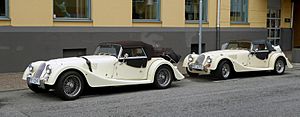
Production of the 4/4 stopped during World War II but started again afterward. It stopped again in 1950 when the Standard engine was no longer available. However, production resumed in 1955 when a suitable Ford engine was found. The 4/4 has been made ever since.
Today, the 4/4 uses the same frame as the +8 model and a Ford engine.
Morgan +8
Morgan started putting the Rover V8 engine in their cars in 1968. These cars were called the "+8" models. This happened because it was becoming harder to find large four-cylinder engines for the +4 models.
The engine size increased from 2.1 liters to 3.5, then 3.9, and later 4.0 liters. An optional 4.6-liter engine was also available. All these engines were based on the same Land Rover design. Even though the V8 engine was bigger, it was not heavier than the Triumph engine. This made the +8 cars much faster than the early +4s and also improved how well they handled on the road.
The horsepower, weight, and performance of the +8 changed over time due to different laws about emissions and car structure. The car could go from 0 to 60 mph in 5.6 seconds. In its final version, the Land Rover V8 engine produced 190 horsepower.
Roadster
In 2004, Morgan released a new model with a traditional look, called the Roadster. It replaced the Plus 8. The first Roadsters had a Ford UK Mondeo V6 engine that produced 223 horsepower. Later versions had a Ford gearbox and a 204 horsepower Ford UK Mondeo V6 engine. From 2011 to 2012, the engine was replaced with a 3.7 Duratec Cyclone engine, increasing the power to 280 horsepower. Morgan calls this newest model the Roadster 3.7.
Morgan Aero 8 (Series I-V)
The Morgan Aero 8 was introduced in 2000. Like other Morgans, it used ash wood for the body's frame. However, the main frame of the Aero 8 is made of aluminum, not wood. The Aero 8 has a BMW V8 engine. It is lighter than a BMW Z4 and much lighter than a BMW M3. This makes the Aero 8 even faster than the Plus 8. Autoweek magazine even called its performance "supercar" level. The newest Aero 8 (Series V), shown in March 2015, produces 367 horsepower. The company says it can reach a top speed of over 170 mph. Because it is so light, the Aero 8 can go from 0 to 62 mph in just 4.5 seconds.
During its production from 2002 to 2009, the Aero 8 had five different versions. These versions had small changes in their style, engines, gearboxes, brakes, and suspension. The company stopped making the model in 2009 but brought it back in 2015 for cars delivered in 2016. The most Aero 8s were produced in 2002.
Morgan AeroMax
After the Aero, Morgan made the Aeromax. This was a special edition coupé version of the Aero 8. Only 100 units were made between 2008 and early 2010. Famous owners included Richard Hammond and Rowan Atkinson.
Morgan Aero SuperSports
The Morgan Aero SuperSports is a version of the AeroMax with a removable roof panel, called a targa-roof. It shares the same aluminum frame and lower body as the coupé. It was first shown at the 2009 Pebble Beach car show in California. Morgan announced in March 2015 that they would stop making this model.
Morgan Aero Coupé
The Morgan Aero Coupé is a hardtop version of the Aero SuperSports. It shares the same aluminum frame, body, suspension, and engine. It was launched at the end of 2011. This model was not available in the United States. Its production was also stopped in March 2015.
Morgan Plus 8 (New Version)
The new Morgan Plus 8 has a classic body style but uses the same modern aluminum frame, body, suspension, and engine as the Aero SuperSports and Aero Coupé. It was launched at the end of 2011. This model was not available in the United States. In 2019, Morgan announced that they would stop making this version.
Morgan Plus E
The Morgan Plus E was an electric version of a classic Morgan car. It was a project between Morgan, Zytek, and Radshape, funded by the UK government. It was shown at the 2012 Geneva Motor Show. However, this car was never produced, and the project was stopped.
Morgan 3-Wheeler
The Morgan Motor Company announced the "3 Wheeler" in 2011 at the Geneva Motor Show. It was said to have a Harley-Davidson V-twin engine and a Mazda 5-speed manual gearbox. It was expected to have 115 horsepower at the rear wheel. However, the production models ended up with S&S engines. The car's weight was about 550 kg. Morgan estimated it could go from 0 to 60 mph in 4.5 seconds, with a top speed of 115 mph. In the United States, the three-wheeler is classified as a motorcycle.
Morgan received 850 orders for the car after its announcement in 2011. Deliveries to customers in Europe began in February 2012. US deliveries started in June 2012. The Morgan 3 Wheeler was featured on the UK TV show Top Gear. Presenter Richard Hammond chose it in a comparison of track-day cars. Top Gear magazine also named the 3 Wheeler "Not-A-Car of the Year 2011."
Morgan SP1
In September 2014, Morgan introduced the Morgan SP1. This car was a special, one-of-a-kind coupé. It used the same Ford 3.7L V6 engine as the Morgan Roadster. The outside look was inspired by Morgan's LIFEcar concept. Its unique wooden frame was made from ash and African Bubinga red hardwood.
Morgan Plus Six
The Morgan Plus Six was announced in March 2019 at the Geneva Motor Show. It has a new aluminum frame and a modern suspension system. This is different from Morgan's traditional ladder frame. The Plus Six is powered by a BMW turbocharged six-cylinder petrol engine, which produces 335 horsepower. It comes with an eight-speed automatic gearbox.
Morgan Plus Four
The Morgan Plus Four was shown online in March 2020. Like the Plus Six, it uses a new aluminum frame and modern suspension. The Plus Four has a BMW turbocharged four-cylinder petrol engine that makes 255 horsepower. You can choose between a six-speed manual or an eight-speed automatic gearbox.
Morgan Super 3
The Morgan Super 3 is a three-wheeled car that came out in 2022. It replaced the Morgan 3-Wheeler, which stopped being made a year earlier. It uses the same platform as Morgan's Plus Four and Plus Six models. However, it does not have the traditional wood panels.
Morgan Midsummer
The Morgan Midsummer was a special, limited-edition car released in 2024. It was a collaboration between Morgan and an Italian design company called Pininfarina. Only fifty of these cars were made, and all of them were sold before the price was even announced!
Morgan Supersport
The Morgan Supersport was revealed in March 2025 at the company's factory. The event was broadcast live online and hosted by Richard Hammond. The Supersport features a new aluminum platform. The company describes it as a "contemporary" redesign of its classic look. They hope it will appeal to more people.
Morgan Cars in the United States
For some years in the 1950s and 1960s, the United States was Morgan's biggest market. Up to 85% of all cars made were sold there. This changed in 1971 when the US introduced new safety and emission rules. For many years (1974 to 1992), all Morgans brought into the US had to be changed to run on propane fuel to meet emission rules. These changes were done by the car dealerships, not the factory.
However, from 1992 to 1996, and again from 1998 to 2004, Morgan was able to sell its cars in the US without these special changes. This was because the Rover Group had updated their V8 engine to meet US rules for the Range Rover. In 2005, that engine was replaced with a V6 engine in a new model called the Roadster.
In 2005, the new Morgan Aero 8 model (versions 2 and 3) received a special permission to be sold in the US for three years, even though it didn't fully meet some safety rules. This permission ended in May 2008.
In April 2012, the new Morgan 3-Wheeler was shown at the New York International Auto Show. This was the first time in 10 years that Morgan had a car at a major American car show. The Morgan 3 Wheeler was even called one of the "Hottest Cars Of The Show" by G4TV.
In May 2012, a special Superdry edition Morgan 3-Wheeler was driven across the United States, from New York to Los Angeles. This car covered 3000 miles in the Gumball 3000 event. At the end of the drive, the Morgan 3 Wheeler won the "Spirit of Gumball" award.
The Morgan 3 Wheeler sold well in the United States until production stopped in 2019. Its replacement, the Super 3, became available in the United States in 2023. Since the Super 3 is classified as a motor tricycle, it does not have to meet the same strict rules as regular cars.
Car Characteristics
Even though Morgan cars have a traditional design, they have always been known for being sporty and fast. This is because they are very light.
In Australia, Morgan cars are sometimes called "Moggies" by their fans.
Suspension System
H.F.S. Morgan's first car in 1909 used a special type of front suspension called "sliding pillar suspension." In this system, each front wheel moves up and down on a fixed pole, which helps the wheel respond better to bumps in the road.
Morgan has used updated versions of this suspension system for a very long time. It is still used on Morgan's "classic" car line. However, it is not used on the Aero 8 or its related models. The classic line, including this suspension, was stopped in 2019. However, some "classic" parts are still sent to the US to be put together there.
Morgan Car Models
- 1909 Runabout
- 1911–1939 V-Twin 3-wheeler
- 1932–1952 F-Series 3-wheeler
- 1936–2018 4/4 Two-Seater and Four-Seater
- 1950–1969 Plus 4
- 1964–1967 Plus 4 Plus
- 1965-1967 Morgan +4 Competition two seater
- 1968–2004 (and 2012–19) Plus 8
- 1985–2000 Plus 4
- 2001–2009 Aero 8
- 2004–2012 V6 Roadster
- 2005–2020 Plus 4
- 2006 Morgan LIFEcar
- 2008–2009 AeroMax
- 2009–2018 Morgan 4/4 Sport
- 2010–2015 Aero SuperSports
- 2010–cancelled Morgan Eva GT
- 2011–cancelled Morgan Plus E
- 2011–2012 Morgan Plus 4 Supersports
- 2006–2008 Morgan Anniversary 4/4
- 2012–2015 Aero Coupe
- 2012–2021 Morgan 3-Wheeler
- 2012–2019 Morgan Aero 8
- 2012–present Roadster 3.7
- 2015–2019 Morgan Aero 8
- 2018 Morgan EV3
- 2019–2025 Morgan Plus Six
- 2020–present Morgan Plus Four
- 2021 Morgan Plus Four CX-T
- 2021 Morgan Plus 8 GTR
- 2022–present Morgan Super 3
- 2024–present Morgan Midsummer
- 2025–present Morgan Supersport
Morgan in Motorsports
Morgan cars are often seen in many types of car racing. This includes local club races, historic car races, and even famous events like the Le Mans 24-hour race. One well-known Morgan racecar was the Aero 8 GT car. It competed in Britcar races and the Britcar 24hrs at Silverstone in 2008.
For the 2012 24 Hours of Le Mans race, a team called Pescarolo Sport renamed their race car a Morgan. This was partly to celebrate 50 years since a Morgan Plus Four Super Sports won its class at Le Mans.
See also
 In Spanish: Morgan Motor Company para niños
In Spanish: Morgan Motor Company para niños
- List of car manufacturers of the United Kingdom
- List of motorized trikes


